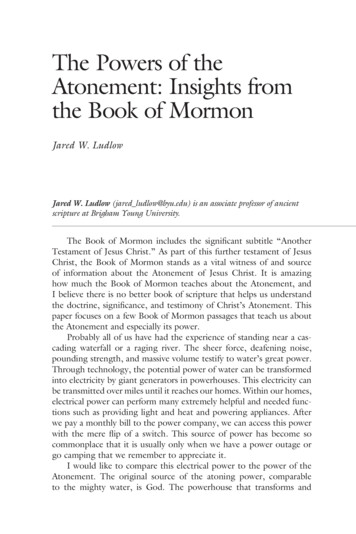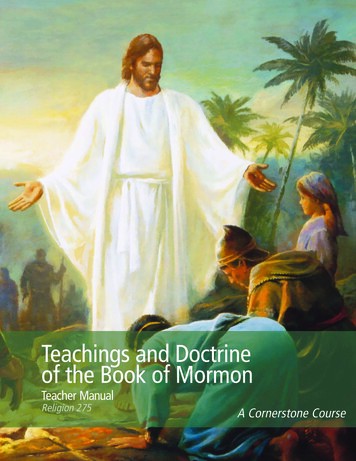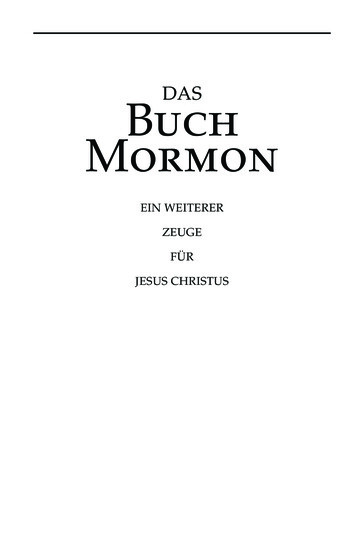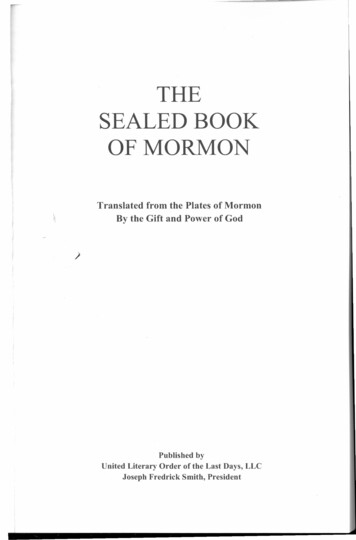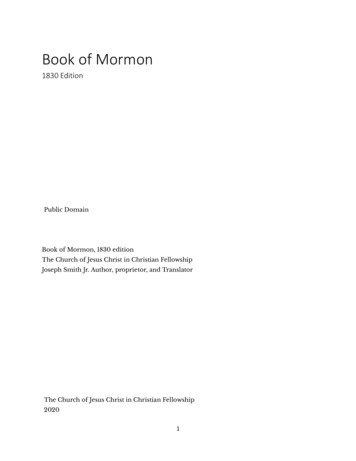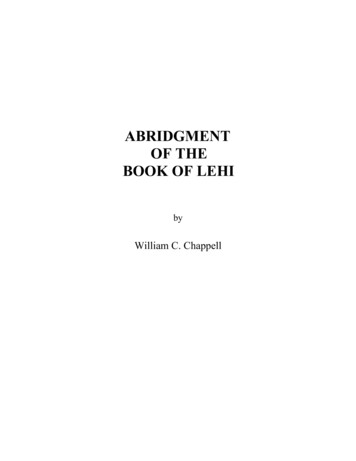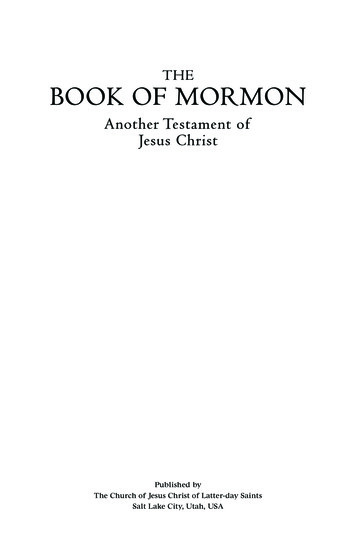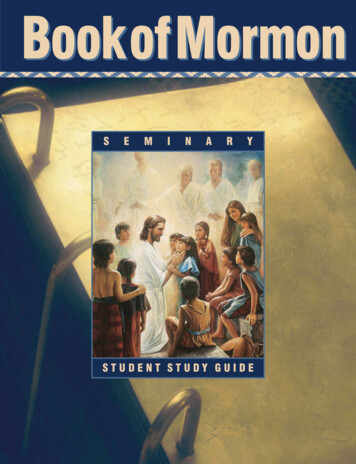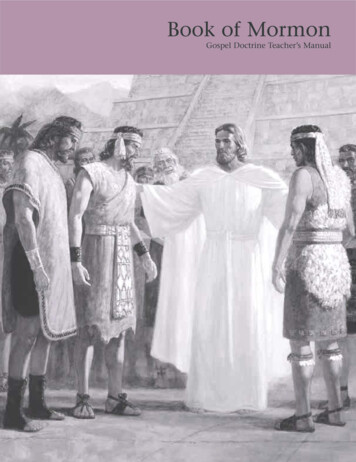
Transcription
Book of MormonGospel Doctrine Teacher’s Manual
Book of MormonGospel Doctrine Teacher’s ManualPublished byThe Church of Jesus Christ of Latter-day SaintsSalt Lake City, Utah
Comments and SuggestionsYour comments and suggestions aboutthis manual would be appreciated.Please submit them to:Curriculum Planning50 E. North Temple St., Rm. 2420Salt Lake City, UT 84150-3220USAE-mail: cur-development@ldschurch.orgPlease list your name, address, ward, andstake. Be sure to give the title of the manual.Then offer your comments and suggestionsabout the manual’s strengths and areas ofpotential improvement.Cover: Christ with Three Nephite Disciples, by Gary L. Kapp 1999 by Intellectual Reserve, Inc.All rights reservedUpdated 2003Printed in the United States of AmericaEnglish approval: 4/03
ContentsLesson Number and TitleHelps for the TeacherPagev1“The Keystone of Our Religion”12“All Things According to His Will” (1 Nephi 1–7)63The Vision of the Tree of Life (1 Nephi 8–11; 12:16–18; 15)114“The Things Which I Saw While I Was Carried Away in the Spirit”(1 Nephi 12–14)165“Hearken to the Truth, and Give Heed unto It” (1 Nephi 16–22)206“Free to Choose Liberty and Eternal Life” (2 Nephi 1–2)257“I Know in Whom I Have Trusted” (2 Nephi 3–5)298“O How Great the Goodness of Our God” (2 Nephi 6–10)339“My Soul Delighteth in the Words of Isaiah” (2 Nephi 11–25)3710“He Inviteth All to Come unto Him” (2 Nephi 26–30)4211“Press Forward with a Steadfastness in Christ” (2 Nephi 31–33)4712“Seek Ye for the Kingdom of God” (Jacob 1–4)5113The Allegory of the Olive Trees (Jacob 5–7)5614“For a Wise Purpose” (Enos, Jarom, Omni, Words of Mormon)6115“Eternally Indebted to Your Heavenly Father” (Mosiah 1–3)6616“Ye Shall Be Called the Children of Christ” (Mosiah 4 –6)7117“A Seer . . . Becometh a Great Benefit to His Fellow Beings”(Mosiah 7–11)7518“God Himself . . . Shall Redeem His People” (Mosiah 12–17)7919“None Could Deliver Them but the Lord” (Mosiah 18–24)8420“My Soul Is Pained No More” (Mosiah 25–28; Alma 36)8921“Alma . . . Did Judge Righteous Judgments” (Mosiah 29; Alma 1–4)9422“Have Ye Received His Image in Your Countenances?” (Alma 5–7)9823“More Than One Witness” (Alma 8–12)10224“Give Us Strength According to Our Faith . . . in Christ” (Alma 13–16)10725“They Taught with Power and Authority of God” (Alma 17–22)11226“Converted unto the Lord” (Alma 23–29)11627“All Things Denote There Is a God” (Alma 30 –31)120iii
iv28“The Word Is in Christ unto Salvation” (Alma 32–35)12429“Give Ear to My Words” (Alma 36–39)12830“The Great Plan of Happiness” (Alma 40–42)13331“Firm in the Faith of Christ” (Alma 43–52)13832“They Did Obey . . . Every Word of Command with Exactness”(Alma 53–63)14233“A Sure Foundation” (Helaman 1–5)14634“How Could You Have Forgotten Your God?” (Helaman 6–12)15035“Repent and Return unto the Lord” (Helaman 13–16)15536“On the Morrow Come I into the World” (3 Nephi 1–7)16037“Whosoever Will Come, Him Will I Receive” (3 Nephi 8–11)16438“Old Things Are Done Away, and All Things Have Become New”(3 Nephi 12–15)16839“Behold, My Joy Is Full” (3 Nephi 17–19)17340“Then Will I Gather Them In” (3 Nephi 16; 20–21)17741“He Did Expound All Things unto Them” (3 Nephi 22–26)18142“This Is My Gospel” (3 Nephi 27–30; 4 Nephi)18543“How Could Ye Have Departed from the Ways of the Lord?”(Mormon 1–6; Moroni 9)19044“I Speak unto You As If Ye Were Present” (Mormon 7–9)19445“Never Has Man Believed in Me As Thou Hast” (Ether 1–6)19846“By Faith All Things Are Fulfilled” (Ether 7–15)20247“To Keep Them in the Right Way” (Moroni 1–6)20648“Come unto Christ” (Moroni 7–8; 10)210
Helps for the TeacherIn a meeting with the Twelve Apostles, the Prophet Joseph Smith “told thebrethren that the Book of Mormon was the most correct of any book on earth,and the keystone of our religion, and a man would get nearer to God by abidingby its precepts, than by any other book” (History of the Church, 4:461; see alsothe introduction to the Book of Mormon).As a Gospel Doctrine teacher, you have the opportunity this year to teach from“the most correct of any book on earth.” Guided by the Spirit, you will be able tohelp class members understand eternal precepts and strengthen their testimoniesof Jesus Christ, His gospel, and the Prophet Joseph Smith’s mission. You will alsobe able to help them receive other blessings that come from diligent study of theBook of Mormon, some of which were described by President Ezra Taft Benson:“The Book of Mormon exposes the enemies of Christ. It confounds falsedoctrines and lays down contention. (See 2 Ne. 3:12.) It fortifies the humblefollowers of Christ against the evil designs, strategies, and doctrines of thedevil in our day. The type of apostates in the Book of Mormon are similar tothe type we have today. God, with his infinite foreknowledge, so molded theBook of Mormon that we might see the error and know how to combat falseeducational, political, religious, and philosophical concepts of our time”(in Conference Report, Apr. 1975, 94–95; or Ensign, May 1975, 64).“There is a power in the book which will begin to flow into your lives themoment you begin a serious study of the book. You will find greater power toresist temptation. You will find the power to avoid deception. You will find thepower to stay on the strait and narrow path. . . . When you begin to hungerand thirst after those words, you will find life in greater and greater abundance”(in Conference Report, Oct. 1986, 6; or Ensign, Nov. 1986, 7).As you teach, the Spirit of the Lord will bear witness to you of the power of theBook of Mormon in bringing people to a firm and steadfast knowledge of JesusChrist and His doctrine.Teaching bythe SpiritWhen preparing for Gospel Doctrine class, it is important that you seek inspiration and guidance from the Holy Ghost. “The Spirit shall be given untoyou by the prayer of faith,” said the Lord, “and if ye receive not the Spirit yeshall not teach” (D&C 42:14). Remember that the Holy Ghost is to be theteacher in your class.You can seek the Spirit by praying, fasting, studying the scriptures daily, andobeying the commandments. While preparing for class, pray for the Spirit tohelp you understand the scriptures and the needs of class members. The Spiritcan also help you plan meaningful ways to discuss the scriptures and applythem to the present (see 1 Nephi 19:23). With the guidance of the Spirit, youv
will become an effective instrument in the hands of the Lord to teach His wordto His children.Some suggestions for how to invite the Spirit into your class are given below:1. Invite class members to offer prayers before and after the lesson. During class,pray in your heart for the Spirit to guide you, to open the hearts of classmembers, and to testify and inspire.2. Use the scriptures (see “Focusing on the Scriptures” below).3. Bear testimony whenever the Spirit prompts you, not just at the end of thelesson. Testify of Jesus Christ. Frequently invite class members to bear theirtestimonies.4. Use hymns, Primary songs, and other sacred music to prepare class members’hearts to feel the Spirit.5. Express love for class members, for others, and for Heavenly Father andJesus Christ.6. As appropriate, share insights, feelings, and experiences that relate to thelesson. Invite class members to do the same. Class members could also tellabout how they have applied principles discussed in previous lessons.Focusing onthe ScripturesElder Boyd K. Packer taught, “True doctrine, understood, changes attitudes andbehavior” (in Conference Report, Oct. 1986, 20; or Ensign, Nov. 1986, 17). Inyour preparation and during class, focus on the saving doctrines of the gospelas presented in the scriptures and the teachings of latter-day prophets. Thisrequires that you study the scriptures diligently and prayerfully. The Lordcommanded, “Seek not to declare my word, but first seek to obtain my word,and then shall your tongue be loosed; then, if you desire, you shall have mySpirit and my word, yea, the power of God unto the convincing of men”(D&C 11:21).Encourage class members to bring their scriptures to class every week. Readselected scripture passages together as you discuss them. Where possible, useLatter-day Saint editions of the scriptures.Each class member should be given a copy of the Book of Mormon Class MemberStudy Guide (35684). This booklet will help class members improve their studyskills. It will help them understand the scriptures, apply them, prepare to discussthem in class, and use them in family discussions. Encourage class members toread the appropriate scripture block and study guide section before coming toclass each week.Sharing theBook of MormonPresident Ezra Taft Benson challenged members of the Church to share the Bookof Mormon. He said:“The time is long overdue for a massive flooding of the earth with the Bookof Mormon. . . . God will hold us accountable if we do not now move the Bookof Mormon in a monumental way.vi
Helps for the Teacher“We have the Book of Mormon, we have the members, we have the missionaries,we have the resources, and the world has the need.“The time is now!” (in Conference Report, Oct. 1988, 4; or Ensign, Nov. 1988, 4–5).As you teach the Book of Mormon in Sunday School this year, encourage classmembers to share the Book of Mormon with their nonmember friends andacquaintances (see the second additional teaching idea in lesson 1). At thebeginning of the year, you may want to consult with the bishopric and wardmission leader about how class members can obtain copies of the Book ofMormon to share with others.Using ThisManualThis manual is a tool to help you teach the doctrines of the gospel from thescriptures. It has been written for youth and adult Gospel Doctrine classes andis to be used every four years. Additional references and commentaries shouldnot be necessary to teach the lessons. Elder M. Russell Ballard said: “Teacherswould be well advised to study carefully the scriptures and their manuals beforereaching out for supplemental materials. Far too many teachers seem to strayfrom the approved curriculum materials without fully reviewing them. If teachersfeel a need to use some good supplemental resources beyond the scriptures andmanuals in presenting a lesson, they should first consider the use of the Churchmagazines” (in Conference Report, Apr. 1983, 93; or Ensign, May 1983, 68).Review each lesson at least a week in advance. When you study the readingassignment and the lesson material early, you will receive thoughts and impressions during the week that will help you teach the lesson. As you ponderthe lesson during the week, pray for the Spirit to guide you. Have faith thatthe Lord will bless you.Each lesson in this manual contains more information than you will probablybe able to teach in one class period. Seek the Spirit of the Lord in selecting thescripture accounts, questions, and other lesson material that will best meet theneeds of class members.Each lesson includes the following sections:1. Title. The title consists of two elements: a short descriptive quotation or phraseand the scriptures you should read as you prepare the lesson.2. Purpose. The purpose statement suggests a main idea you can focus on as youprepare and teach the lesson.3. Preparation. This section summarizes the scripture accounts in the lessonoutline. It may also include additional reading and other suggestions forpreparation, such as materials you may want to bring to class. Many of thesematerials are available in the meetinghouse library. (A five-digit numberfollowing the name of a suggested picture is the meetinghouse library number;if the picture is included in the Gospel Art Picture Kit [34730], that number isalso given.)4. Attention activity. This section consists of a simple activity, object lesson,quotation, or question to help class members prepare to learn, participate,and feel the influence of the Spirit. Whether you use the manual’s attentionvii
activity or one of your own, it is important to focus class members’ attentionat the beginning of the lesson. The activity should be brief.5. Scripture discussion and application. This is the main part of the lesson. Prayerfullystudy the scripture accounts so you can teach and discuss them effectively. Usethe suggestions in “Encouraging Class Discussion” (pages viii–ix) and “UsingVariety in Teaching the Scriptures” (pages ix–x) to vary the way you teach andto maintain class members’ interest. Select questions and methods that areappropriate for class members’ ages and experience.6. Conclusion. This section helps you summarize the lesson and encourage classmembers to live the principles you have discussed. It also reminds you to beartestimony. Be sure to leave enough time to conclude each lesson.7. Additional teaching ideas. This section is provided in most lessons in the manual.It may include additional truths from the scripture accounts, alternate teachingapproaches, activities, or other suggestions that supplement the lesson outline.You may want to use some of these ideas as part of the lessons.EncouragingClass DiscussionYou normally should not give lectures. Instead, help class members participatemeaningfully in discussing the scriptures. Class members’ participation helpsthem:1. Learn more about the scriptures.2. Learn how to apply gospel principles.3. Become more committed to living the gospel.4. Invite the Spirit into the class.5. Teach and edify each other so they benefit from each other’s gifts, knowledge,experience, and testimonies.Discussions should help class members draw nearer to the Savior and live asHis disciples. Redirect discussions that do not accomplish these purposes.Asking thought-provoking questions can be one of the most effective teachingtechniques. It is a technique the Savior used when He taught. Seek the Spirit’sguidance as you study the questions in this manual and decide which ones toask. The manual provides scripture references to help you and class membersfind answers to most of these questions. Answers to other questions will comefrom class members’ experiences.It is more important to help class members understand and apply the scripturesthan to cover all the lesson material you have prepared. If class members arelearning from a good discussion, it is often helpful to let it continue rather thantry to cover all the lesson material.Use the following guidelines to encourage class discussion:1. Ask questions that require thought and discussion rather than questions thatcan be answered with yes or no. Questions that begin with why, how, who,what, when, and where are usually most effective for encouraging discussion.2. Encourage class members to share experiences that show how scripturalprinciples and doctrines can be applied to life. Also encourage them toviii
Helps for the Teachershare their feelings about what they are learning from the scriptures. Showappreciation for their contributions.3. Be sensitive to the needs of each class member. Although all class membersshould be encouraged to participate in class discussions, some may hesitate torespond. You may wish to speak privately with them to find out how they feelabout reading aloud or participating in class. Be careful not to call on classmembers if it might embarrass them.4. Give scripture references to help class members find the answers to somequestions.5. Encourage class members to ponder the questions in the Book of MormonClass Member Study Guide as they study each week’s reading assignment. Asyou prepare each lesson, consider how to discuss these questions in class.Class members will be better able to participate in discussions if they havestudied the reading assignment and if you ask questions that they areprepared to answer.Using Variety inTeaching theScripturesUse the following suggestions to teach scripture accounts more effectively andwith greater variety:1. Help class members understand what the scriptures teach about Jesus Christ.Ask them to consider how certain passages increase their faith in the Saviorand help them feel His love.2. Ask class members to think of and share specific ways that a scripture passagecan apply in their lives. Have them personalize the scriptures by mentallysubstituting their names in selected passages.3. In addition to teaching the doctrine, emphasize inspiring stories in the Bookof Mormon. Ensure that class members understand the stories and discussways to apply them. Ask, “Why do you think this account was included inthe Book of Mormon?” or “What can we learn from this story to help us bebetter followers of Christ?”4. Have class members look for words, phrases, or ideas that are repeated oftenin a scripture passage or that have special meaning for them.5. Encourage class members to use the study aids included at the end of theLatter-day Saint editions of the Bible and the Book of Mormon, such as theTopical Guide and Bible Dictionary for the Bible and the index for the Bookof Mormon.6. Write on the chalkboard phrases, key words, or questions that relate to thescripture account. Then read or summarize the account. As class membershear the phrases, key words, or answers to the questions, stop and discussthem.7. Throughout the Book of Mormon, the phrase “thus we see” is used tointroduce a summary of the principles taught (see, for example, Helaman3:28). After reading a scripture passage, ask class members to explain thepassage using the phrase “thus we see.”ix
8. Look for and discuss symbols that are used in the Book of Mormon. Forexample, a strait and narrow path is often used to symbolize the gospel(see 2 Nephi 31:17–20; 33:9; Jacob 6:11; 3 Nephi 14:13–14; 27:33).9. Note how people or events in the scriptures can be contrasted or comparedwith each other. For example, you could contrast Laman and Lemuel withtheir brothers Nephi and Sam, or compare the Savior’s Sermon on the Mountas recorded in the New Testament with the account in 3 Nephi 12–14.10. Have class members dramatize scriptural stories by reading aloud the wordsof the different people in the stories. Ensure that dramatizations show properrespect for the scriptures.11. Divide the class into two or more small groups. After reviewing a scriptureaccount, have each group write down the principles and doctrines taught inthe account. Then have the groups take turns discussing how these teachingsapply in their lives.12. Invite class members to bring pencils to mark significant verses as theydiscuss them.13. Show segments from Book of Mormon Video Presentations (53911) as suggestedin the “Preparation” section of various lessons.HelpingNew MembersYou may have the opportunity to teach members who are relatively new inthe Church. Your teaching can help these members become firm in the faith.The First Presidency has said: “Every member of the Church needs to be lovedand nourished, especially during the first few months after baptism. When newmembers receive sincere friendship, opportunities to serve, and the spiritualnourishment that comes from studying the word of God, they experienceenduring conversion and become ‘fellowcitizens with the saints, and of thehousehold of God’ (Ephesians 2:19)” (First Presidency letter, 15 May 1997).Teaching theGospel to YouthxIf you are teaching youth, remember that they often need active participationand visual representations of the doctrines being discussed. Your use of videopresentations, pictures, and activities suggested in the manual can help youthstay interested in the lessons. For other ideas to help you teach the gospel toyouth, refer to Teaching, No Greater Call (36123) and the Teaching Guidebook(34595).
“The Keystoneof Our Religion”Lesson1PurposeTo help class members understand how the Book of Mormon is the keystone ofour religion and how abiding by its precepts helps us draw nearer to God.Preparation1. Read, ponder, and pray about the following scriptures: 1 Nephi 13:38–41;19:23; 2 Nephi 25:21–22; 27:22; 29:6–9; Mormon 8:26–41; Ether 5:2–4;Moroni 1:4; 10:3–5; Doctrine and Covenants 10:45–46; 20:8–12; 84:54–58.Also study the introductory material to the Book of Mormon, including thetitle page, the introduction, the Testimony of Three Witnesses, the Testimonyof Eight Witnesses, and the Testimony of the Prophet Joseph Smith.2. Additional reading: “The Book of Mormon—Keystone of Our Religion” (EzraTaft Benson, Ensign, Nov. 1986, 4–7; see also Conference Report, Oct. 1986, 3–7).3. Obtain a copy of the Book of Mormon Class Member Study Guide (35684) for eachclass member. (You should receive copies from the Sunday School presidency.)4. In advance, ask one class member to prepare to summarize the Testimony of theProphet Joseph Smith, another to prepare to summarize the Testimony of ThreeWitnesses, and a third to prepare to summarize the Testimony of Eight Witnesses.5. If the following materials are available, prepare to use them during the lesson:a. The pictures Moroni Appears to Joseph Smith in His Room (62492; GospelArt Picture Kit 404) and Joseph Smith Receives the Gold Plates (62012;Gospel Art Picture Kit 406).b. “For Our Day,” a four-minute segment of Book of Mormon Video Presentations(53911).Suggestions forLesson DevelopmentAttention ActivityAs appropriate, use the following activity or one of your own to begin the lesson.Draw a stone arch on the chalkboard:1
Explain that when an arch such as this one is constructed correctly, it canremain standing even without any mortar between the stones. What holds the arch together?Write the word keystone on the center stone of the arch. Explain that thekeystone of an arch holds the other stones in place. This lesson discussesthe keystone of The Church of Jesus Christ of Latter-day Saints.Scripture Discussion Prayerfully select the scripture passages, questions, and other lesson material thatwill best meet class members’ needs. Discuss how the selected scriptures apply toand Applicationdaily life. Encourage class members to share appropriate experiences that relateto the scriptural principles.1. The Book of Mormon is the keystone of our religion.Have class members turn to the introduction to the Book of Mormon, and invitea class member to read the sixth paragraph.If you used the attention activity, write Book of Mormon on the chalkboard underthe word keystone.If you did not use the attention activity, write on the chalkboard Book of Mormon keystone and explain that the keystone of an arch holds the other stones inplace and prevents the arch from collapsing. Why do you think Joseph Smith called the Book of Mormon the keystone ofour religion?President Ezra Taft Benson explained, “Just as the arch crumbles if the keystoneis removed, so does all the Church stand or fall with the truthfulness of theBook of Mormon” (in Conference Report, Oct. 1986, 5; or Ensign, Nov. 1986, 6). Why does the Church “stand or fall with the truthfulness of the Book ofMormon”?After discussing this question, have a class member read the following statementby President Benson: “There are three ways in which the Book of Mormon is thekeystone of our religion. It is the keystone in our witness of Christ. It is the keystone of our doctrine. It is the keystone of testimony” (in Conference Report,Oct. 1986, 4; or Ensign, Nov. 1986, 5).Write on the chalkboard Witness of Christ. Have class members turn to the title page of the Book of Mormon, and explainthat this page was written by the prophet Moroni. According to the second paragraph, what are three purposes of the Book of Mormon? (To show the remnantof the house of Israel the great things the Lord has done for their fathers; toteach the covenants required by the Lord; and to convince all people thatJesus is the Christ, manifesting Himself to all nations.) In 1982 the subtitle Another Testament of Jesus Christ was added to the title ofthe Book of Mormon. Why is it important to have this additional testamentof the Savior? (See 1 Nephi 13:38–41; 2 Nephi 29:6–9.) Why is it importantto declare to the world that the Book of Mormon testifies of Christ?2
Lesson 1 What have you learned from the Book of Mormon about Jesus Christ?How has the Book of Mormon strengthened your testimony of Jesus Christ?Write on the chalkboard Doctrine. In what ways is the Book of Mormon the “keystone of our doctrine”? (SeeD&C 10:45–46; 20:8–12.)President Benson stated: “The Lord Himself has stated that the Book of Mormoncontains the ‘fulness of the gospel of Jesus Christ’ (D&C 20:9). That does notmean it contains every teaching, every doctrine ever revealed. Rather, it meansthat in the Book of Mormon we will find the fulness of those doctrines requiredfor our salvation. And they are taught plainly and simply so that even childrencan learn the ways of salvation and exaltation” (in Conference Report, Oct.1986, 4; or Ensign, Nov. 1986, 6). How has the Book of Mormon increased your understanding of importantgospel doctrines?Write on the chalkboard Testimony. Why is the Book of Mormon fundamental to a testimony of the restoredgospel? What blessings come to those who receive a testimony of the Book ofMormon and follow its teachings? What must we do to gain a testimonyof the truthfulness of the Book of Mormon? (See Moroni 10:3–5.)Invite class members to talk about how they came to know that the Book ofMormon is true.2. Many witnesses have testified of the Book of Mormon.If you are using the pictures of Moroni appearing to Joseph Smith and of JosephSmith receiving the gold plates, display them now. Have the assigned class membersummarize the events recorded in the Testimony of the Prophet Joseph Smith. Thenexplain that after Joseph Smith had finished translating the Book of Mormon, otherpeople were privileged to see the plates. Have the assigned class members presenttheir summaries of the Testimony of the Three Witnesses and the Testimony of theEight Witnesses. Why was it important to have witnesses of the gold plates? (See Ether 5:2–4.)How do you think having additional witnesses helped the Prophet JosephSmith? What other witnesses do we have that the Book of Mormon is true?If you are using the video presentation “For Our Day,” show it now.3. The Book of Mormon was written for our day.Point out that although the Book of Mormon is an ancient document, it waswritten and preserved for our day (2 Nephi 25:21–22; 27:22; Mormon 8:34–35;Moroni 1:4). Read with class members Mormon 8:26–41. Explain that these verses containa prophecy about the coming forth of the Book of Mormon. What conditionsdid Moroni foresee would exist in the world when the Book of Mormon was3
again brought forth? (Write class members’ responses on the chalkboard.Answers may include those in the list below.) How are these conditionsevident in the world today?a. “The power of God shall be denied” (verse 28).b. “There shall be great pollutions upon the face of the earth” (verse 31).c. People will “lift themselves up in the pride of their hearts” (verse 36).d. People will “love money . . . more than [they] love the poor and the needy”(verse 37).e. People will be “ashamed to take upon [themselves] the name of Christ”(verse 38). In what ways can the teachings of ancient prophets be a source of help tous? How might knowing that the Book of Mormon was written for our dayinfluence the way we study it? (See 1 Nephi 19:23.)President Benson taught: “The Book of Mormon . . . was written for our day.The Nephites never had the book; neither did the Lamanites of ancient times.It was meant for us. . . . Each of the major writers of the Book of Mormontestified that he wrote for future generations. . . . If they saw our day andchose those things which would be of greatest worth to us, is not that howwe should study the Book of Mormon? We should constantly ask ourselves,‘Why did the Lord inspire Mormon (or Moroni or Alma) to include that inhis record? What lesson can I learn from that to help me live in this dayand age?’ ” (in Conference Report, Oct. 1986, 5; or Ensign, Nov. 1986, 6).4. The Book of Mormon can bring us nearer to God.Have a class member again read the sixth paragraph of the introduction to theBook of Mormon. What are precepts? (Commandments or principles.) How can the precepts ofthe Book of Mormon bring us nearer to God? If we do not study the Book of Mormon, what will be the consequences to us,individually and as a church? (See D&C 84:54–58.) What changes and blessings have come into your life when you have studiedand pondered the Book of Mormon regularly?ConclusionRead or have a class member read the following statement by President Ezra TaftBenson:“The moment you begin a serious study of [the Book of Mormon, you] will findgreater power to resist temptation. You will find the power to avoid deception. Youwill find the power to stay on the strait and narrow path. . . . When you begin tohunger and thirst after those words, you will find life in greater and greaterabundance” (in Conference Report, Oct. 1986, 6; or Ensign, Nov. 1986, 7).Encourage class members to experience the fulfillment of these promises forthemselves by studying the Book of Mormon this year.As directed by the Spirit, testify of the truths discussed during the lesson.Give each class member a study guide. Encourage class members to use thesestudy guides as they study the scriptures in preparation for class each week.4
Lesson 1AdditionalTeaching IdeasThe following material supplements the suggested lesson outline. You may wantto use one or both of these ideas as part of the lesson.1. The importance of the Book of Mormon in the Restoration of the gospelList the following phrases on the chalkboard without the accompanying numbers:6. Temple work for the dead begins.3. The Melchizedek Priesthood is restored.5. Apostles are called.1. Joseph Smith receives the First Vision.4. The Church is organized.2. The Book of Mormon comes forth.Ask class members to identify the order in which these events occurred (thenumbers to the left of the events indicate their correct order; add these numbers tothe ch
Book of Mormon President Ezra Taft Benson challenged members of the Church to share the Book of Mormon. He said: . Manual This manual is a tool to help you teach the doctrines of the gospel from the scriptures. It has bee
